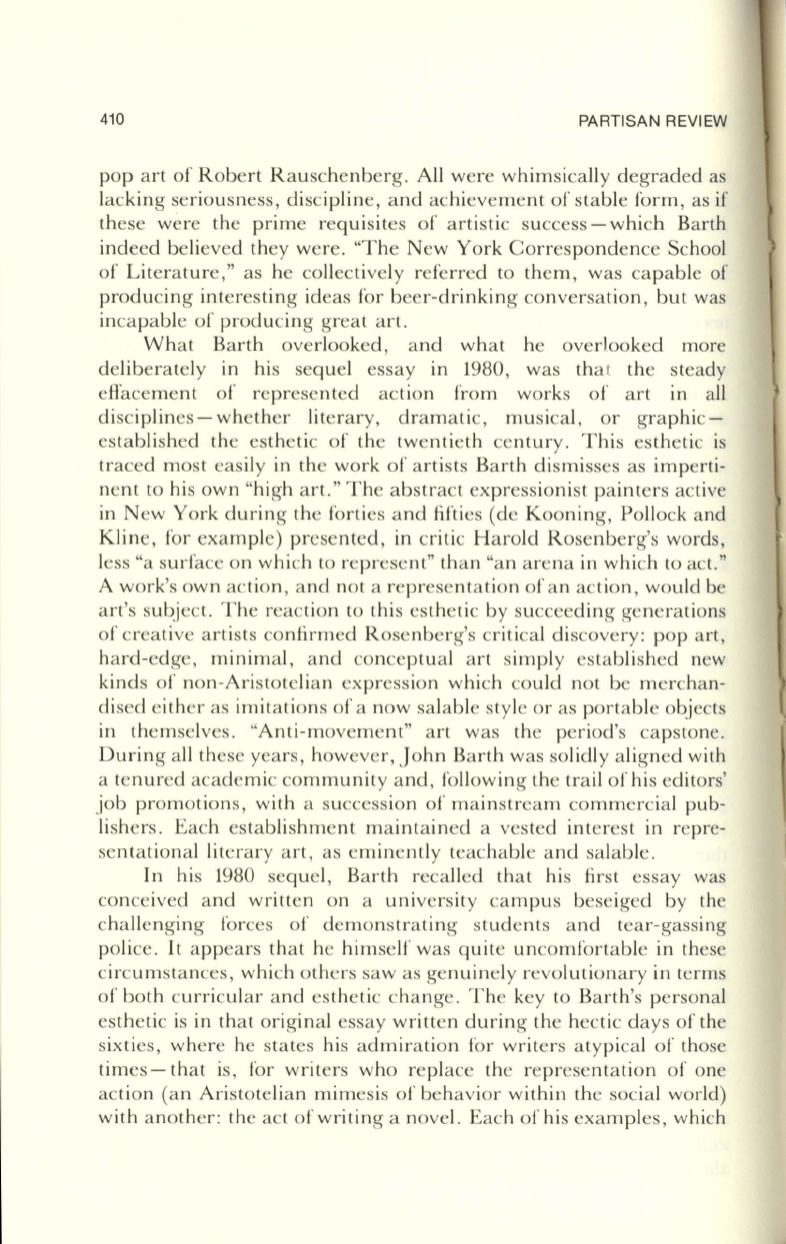
410
PARTISAN REVIEW
pop art of R obe r t R auschenbe rg. All were whi ms icall y degraded as
lacking se riousness, di sci pline, a nd achi evemen t of stable form , as if
these were the prime requisites of art isti c success - which Barth
indeed believed they were . "The New York Corres pondence School
of Li terature," as he collecti vely referred to them , was capa ble of
producin g interest in g ideas for bee r-drinking conversation , bu t was
incapa ble of producing great a r t.
Wha t Ba rth overl ooked , a nd wha t he ove rl ooked more
deli be rately in hi s sequel essay in 1980 , was tha t the steady
effacement of represen ted act ion from works o f a rt in all
disciplines - whether li te ra ry, drama tic, musical, or graphic –
es ta blished the es thetic of the twenti eth ce n tury. T hi s es thetic is
traced mos t eas il y in the work o f a rtists Ba rth d ismisses as imperti–
nen t to hi s own "hi gh art. " T he a b tract express ioni st pa in te rs active
in ew York during the fo rties a nd fifti es (de Koonin g, Poll ock a nd
Kline, for example) pre ented , in critic H a rold R osenberg's words,
less "a surface on whi ch to represen t" tha n "an a re na in whi ch to act. "
A work's own ac tion , a nd not a rep rese nta tion of a n ac tion , would be
a r t's subj ect. T he reaction
to
this es thet ic by succeeding ge ne rat ions
of creati ve a r tists confirmed Rose nbe rg's critical d iscove ry: pop art ,
hard-ed ge, minima l, a nd concep tua l a rt simpl y es tablished new
kinds of non-Aristo tel ia n express ion which coul d not be merchan–
di sed either as imi tat ions of a now salable style or as portable obj ects
in themselves. "Anti-movemen t" a rt was the period's capstone.
During all these yea rs, howeve r , J ohn Ba rth was solidl y a li gned with
a te nu red academic communi ty a nd , fo llowing the tra il of hi s ed itors'
job promot ions, with a success ion of mainstream comme rcia l pub–
lishe rs. Each establishme nt ma inta ined a ve ted interes t in repre–
se nta ti ona l literar y a rt, as emi ne ntl y teachab le a nd salable.
In hi s 1980 sequel, Barth recall ed tha t hi s fi rs t es ay was
conceived a nd written on a uni ve r ity campus bese iged by the
cha ll enging fo rces of demonst ra ting students a nd tear-gassing
police. It a ppears tha t he hi mse lf was quite uncomfo r table in these
circumstances, whi ch others saw as genuinely revoluti ona ry in terms
o f bo th curri cul a r a nd es theti c cha nge. T he key
to
Ba r th's personal
esthetic is in tha t ori gina l essay writte n during the hec ti c days of the
sixti es, where he states hi s admira ti on fo r write rs a typical of those
times - tha t is, fo r write rs who repl ace the represe nta tion of one
acti on (an Ari stoteli a n mimes is o f behav ior within the socia l world)
with a nother : the ac t o f writing a novel. Each of hi s examples, which


